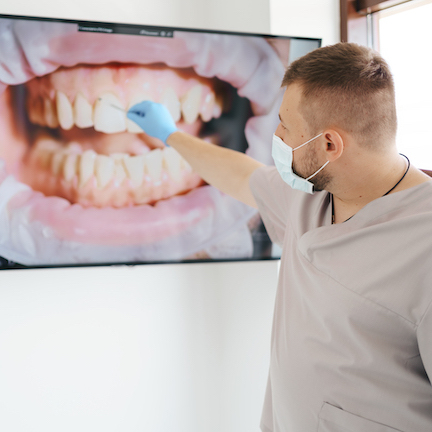Don't leave everything to chance; keep yourself protected with an insurance

Gum recession is a common dental problem. Most people don’t know they have gum recession because it occurs gradually. The first sign of gum recession is usually tooth sensitivity, or you may notice a tooth looks longer than normal. Typically, a notch can be felt near the gum line.
Gum recession is not something you want to ignore. If you think your gums are receding, make an appointment with your dentist. There are treatments that can repair the gum and prevent further damage.
Gum recession is the process in which the margin of the gum tissue that surrounds the teeth wears away, or pulls back, exposing more of the tooth, or the tooth’s root. When gum recession occurs, “pockets,” or gaps, form between the teeth and gum line, making it easy for disease-causing bacteria to build up. If left untreated, the supporting tissue and bone structures of the teeth can be severely damaged, and may ultimately result in tooth loss.
The best way to prevent gum recession is to take good care of your mouth. Brush and floss your teeth every day and see your dentist or periodontist at least twice a year, or as recommended. If you have gum recession, your dentist may want to see you more often. Always use a soft-bristled toothbrush and ask your dentist to show you the proper way to brush your teeth. If a misaligned bite or teeth grinding is the cause of gum recession, talk to your dentist about how to correct the problem. Other ways to prevent gum recession include:
There are a number of factors that can cause your gums to recede, including:
Periodontal diseases
These are bacterial gum infections that destroy gum tissue and supporting bone that hold your teeth in place. Gum disease is the main cause of gum recession.
Your genes
Some people may be more susceptible to gum disease. In fact, studies show that 30% of the population may be predisposed to gum disease, regardless of how well they care for their teeth.
Aggressive tooth brushing
If you brush your teeth too hard or the wrong way, it can cause the enamel on your teeth to wear away and your gums to recede.
Insufficient dental care
Inadequate brushing, flossing, and rinsing with antibacterial mouthwash makes it easy for plaque to turn into calculus, a hard substance that builds on and between your teeth and can only be removed by a professional dental cleaning. It can lead to gum recession.
Hormonal changes
Fluctuations in female hormone levels during a woman’s lifetime, such as in puberty, pregnancy, and menopause, can make gums more sensitive and more vulnerable to gum recession.
Tobacco products
Tobacco users are more likely to have sticky plaque on their teeth that is difficult to remove and can cause gum recession.
Grinding and clenching your teeth
Clenching or grinding your teeth can put too much force on the teeth, causing gums to recede.
Misaligned teeth/bite
When teeth do not come together evenly, too much force can be placed on the gums and bone, allowing gums to recede.
Body piercing of the lip or tongue
Jewellery can rub the gums and irritate them to the point that gum tissue is worn away.
The following surgical procedures are used to treat gum recession:
Open flap scaling and root planing
During this procedure, the dentist or periodontist (gum doctor) folds back the affected gum tissue, removes the harmful bacteria from the pockets, and then snugly secures the gum tissue in place over the tooth root, thus eliminating the pockets or reducing their size.
Regeneration
If the bone supporting your teeth has been destroyed as a result of gum recession, a procedure to regenerate lost bone and tissue may be recommended. As in pocket depth reduction, your dentist will fold back the gum tissue and remove the bacteria. A regenerative material, such as a membrane, graft tissue, or tissue-stimulating protein, will then be applied to encourage your body to naturally regenerate bone and tissue in that area. After the regenerative material is put in place, the gum tissue is secured over the root of the tooth or teeth.
Soft tissue graft
There are several types of gum tissue graft procedures, but the most commonly used one is called a connective tissue graft. In this procedure, a flap of skin is cut at the roof of your mouth (palate) and tissue from under the flap, called subepithelial connective tissue, is removed and then stitched to the gum tissue surrounding the exposed root. After the connective tissue — the graft — has been removed from under the flap, the flap is stitched back down. During another type of graft, called a free gingival graft, tissue is taken directly from the roof of the mouth instead of under the skin. Sometimes, if you have enough gum tissue surrounding the affected teeth, the dentist is able to graft gum from near the tooth and not remove tissue from the palate. This is called a pedicle graft.
Your dentist can determine the best type of procedure to use on you based on your individual needs.
Our dentists continually attend further education and stay on top of current research to bring the best evidence based treatments and the latest techniques.
We use the latest treatment techniques, procedures & dental materials that enable us to deliver a wide range of options to suit your needs.
Also, we use a wide variety of cosmetic dentistry options and treatments to transform your regular smile into a million-dollar one. We offer all your treatments in the same place, whichever specialist you may need to see, you will find them available here.

© 2021 Right Choice Insurance Designed by Amplispot
Privacy Policy | Terms & Conditions